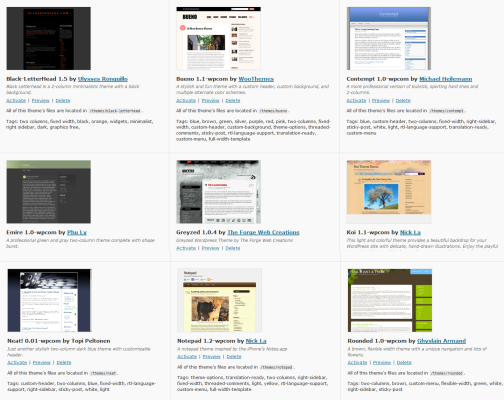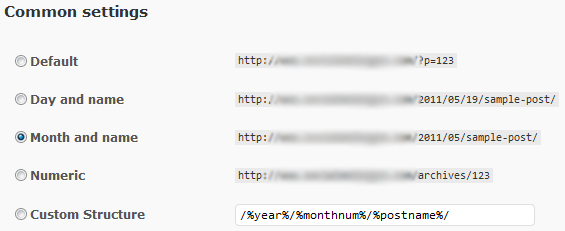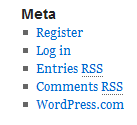
After you’ve installed a fresh copy of WordPress, there are quite a few small helpful tasks you can complete before you get going with content, promotion and theme tweaking. Several of the points below are down to personal preference, whilst others will help you optimise your WordPress website for visitors and search engines. Whether you install lots of copies of WordPress or only install it on average every few years, this list should be helpful to ensure you don’t miss anything. If you’d like to add to our list, just leave a comment at the bottom of the page.
If you don’t have WordPress installed, you can find out more on our WordPress hosting page, or take advantage of our fast one-click install to get up and running.
1. Edit your blog tagline
In your admin panel, head to ‘Settings’ to change the tagline of your blog, which by default will be ‘Just another WordPress weblog’. You can also take this opportunity to change your blog’s main title if you wish.
2.Go through the themes that come with your installation and delete all the ones you’ll never use
Head to ‘Appearance’ in the admin panel to delete additional themes. It saves on updates, space and admin panel loading, and you can always download them again if you change your mind.
3.Change your permalink URLs for SEO
In your admin panel, click ‘Settings’ in the sidebar, then ‘Permalinks’, and choose a setting which is more keyword-friendly.
4.Change the date display to a numerical option
This helps prevent Google seeing months of the year as keywords for your website (as shown in Google Webmaster Tools). Click ‘Settings’ in your admin panel to change it.
5.Delete all the plugins you’ll never use
It’s pretty unlikely that you’ll need to use Hello Dolly, so delete it along with any other plugins you won’t use by clicking the ‘Plugins’ link. The problem here is that you think ‘I might try that out one day’ and keep it just in case. You almost definitely won’t, so delete it to save on updates and loading times.
6.Install/activate/change settings for your essential plugins
Everyone’s list of essential plugins is different, but popular choices include All in One SEO Pack, WP Super Cache, Akismet, Contact Form 7, Ultimate Google Analytics, Google XML Sitemaps and Maintenance Mode.
View WordPress’ list of popular plugins for inspiration.
7.Add a copyright and date line to your footer
Assuming your chosen theme doesn’t already have one, go to Appearance > Editor, then click footer.php on the right. Add the following code:
© <?php $blog_title = get_bloginfo('name'); ?><?php echo date("Y") ?> .
The year will automatically change, and the site title is based on the WordPress blog title you define in your settings.
8.Delete or edit the defaults
WordPress comes with the default ‘Hello World’ entry and comment, plus a sample page. You can edit them if you don’t want to delete them, but remember to edit the URLs/post slugs under the titles.
9.Create the necessary pages
‘About Us’ and ‘Contact Us’ pages make visitors feel more comfortable about your site and don’t require much work, so it’s better to get them up as soon as possible so you can concentrate on other content. You may want to add privacy policy and disclaimer pages as well.
10.Add a tag cloud to your sidebar
Not everyone will want to do this, but it’s good for both search engines and visitors if you can spare the space in your sidebar. A tag cloud helps users see the most common topics of your posts at a glance, and provides a more eye-catching and interesting alternative to simple Categories and Archives browsing. Tag clouds can also help to reduce your website’s bounce rate if visitors spot an unusual or interesting keyword to click.
If you’re interested in adding a tag cloud to your sidebar, you can do it easily following the information here.
11.Put your archives in a drop down menu
This helps stop your sidebar getting cluttered in the long term when you will have lots of links. Insert the following into sidebar.php:
.
Find out more in the WordPress codex.
12.Remove Edit links
Another optional task is to remove the ‘Edit’ link from posts and comments on the front-end of your website. Although only admins and other users with appropriate permissions can see them, it’s less confusing for multi-author blogs and stops you having to edit out links if you take screenshots.
Check out this page of the WordPress codex to find out the code to remove.
13.Edit the Meta box
Some WordPress themes include a ‘Meta’ section with links; we’d strongly advise removing the ‘Log in’ link for security, and you may as well remove any others you won’t need.
If you liked this post, you may also enjoy:
• The WordPress plug-ins you need to make your website more social
• 16 of the best WordPress on WordPress websites
• The complete guide to styling your WordPress comments
• 6 handy WordPress code snippets





Comments
Please remember that all comments are moderated and any links you paste in your comment will remain as plain text. If your comment looks like spam it will be deleted. We're looking forward to answering your questions and hearing your comments and opinions!